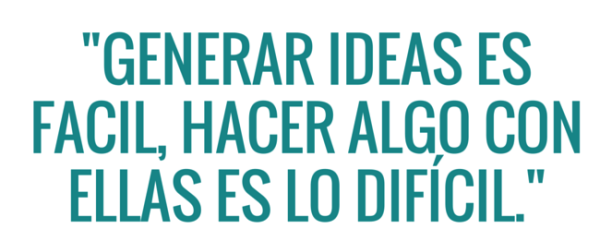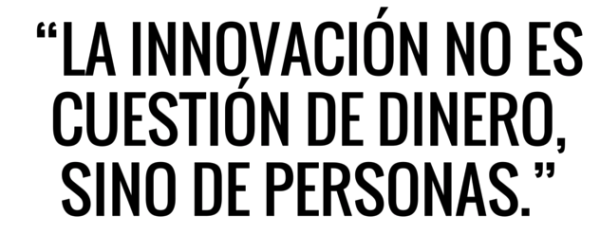I have written a lot and will continue to write about innovation. There are many organizations that make efforts to achieve results that give different responses to existing problems; however, many times, the results are disappointing. Frequently, the problem is that they remain in the limbo of speech and inaction. The truth is that there is no innovation without getting things done, implemented, and presented to the market.
For many leaders, innovation remains a mysterious concept, something they aspire to achieve without even knowing how to define it or how to put it into action in their organizations.
Surely, there will be many executives confused by the verbiage of many television programs and digital platforms that distort the way to achieve the objectives or by myths that generate misunderstandings and prejudices. In any case, there are many who wish to fulfill their entrepreneurial objectives in this field.
We know that our concepts and theories determine our behaviors; it is worth, then, eliminating some of these myths and doing it, moreover, from the objectivity of the data, which is the only reliable source when it comes to making professional decisions.

What are these myths of innovation?
Innovation provides new forms of growth and also improves what already exists in the organization.
However, many times it encounters barriers or obstacles that prevent it from being materialized. One of these obstacles is the existing misinformation in different sectors. This misinformation spawns some myths about innovation.
Today I want to share these myths. I know that there are many more and that you also know other myths that hold back innovation.
Myth No. 1: The moment of divine inspiration
It is common to think that to innovate we need a magical moment of inspiration like lightning and it changes our lives.
Although there may be some truth to that statement, the truth is that good ideas do NOT appear by divine inspiration; rather reality indicates that you have to look for them through hard work. And for that, we have to fully immerse ourselves in what we do, know our services thoroughly, and understand our clients very well.
Everything starts by defining where we want to go in order to know in which direction to walk today; and the more committed we are to reaching that destination, the greater our determination.
Myth No. 2: The lone genius
We tend to think that innovation is a matter of great geniuses and inventors like Nikola Tesla or Steve Jobs. We thought they were people who did everything on their own. However, the truth is that with them there was a team that accompanied them. It is known that Steve Jobs, for his part, an entire organization (without his programmer and partner, Steve Wozniak, it would not even have started, since Jobs had great ideas but did not know how to write code).
Of course, in every innovation process, there is a manager or leader, but the team is a very important factor.
Myth No. 3: Without technology, there is no innovation
In society, it is increasingly associated that innovating is synonymous with technology or that only startups and new entrepreneurs have the capacity to innovate. And that is not true. You can innovate without technology, you can innovate without starting. Perhaps to innovate you only need to serve the customer in a special way or choose another format for selling your products or services, but that will depend on you and your business, not on whether it is big or small, or whether it counts or not. Lots of technology is available.
Myth No. 4: Innovation is pure creativity
You can be innovative in business without being extremely creative.
You can innovate in your business by adapting a process from another country that is not known here. And you haven’t been creative at all. If you do well, your sales can increase and your business grow.
Creativity is a part of innovation, but only that. It is one more piece of the puzzle, always remember that.
The winners are those who can leverage a modern technology infrastructure to drive that innovation, agility, and efficiency.
Myth No. 5: There is no risk in innovation
Without risks, there is no innovation. You may even be good at it, but you know that success is not guaranteed.
If we’re innovating, or thinking of new ways to do new things, while we’re at it, we’re probably going to be wrong. We learn by doing, we learn from mistakes and failures. This always carries risks.

Myth No. 6: Ideas are everything
Make no mistake…ideas alone are worthless, we all have them at all times. The big difference between an entrepreneur and someone who spends his life dreaming of having his own business is that the first one develops and materializes his ideas.
There are plenty of examples and in the fortunes amassed thanks to the digital revolution, it is a pattern that is repeated. We have the case of Jack Ma, the founder of the Asian e-commerce giant called Ali Baba.
Jack Ma’s life was not one brilliant idea after another. Before becoming one of the richest men in the world, he failed the university entrance exam twice and was rejected for more than 30 jobs. This, far from discouraging him, gave him the impulse to continue improving himself. He continued to believe in his idea, but above all, working every day to achieve it.
Myth No. 7: Innovation is expensive and has a lot of risks
Although this statement is true when the innovation is disruptive and requires a large number of resources to be carried out, it is not the case in the rest of the cases. Small and medium-sized companies have the advantage of having a quick capacity to adapt to changes, so they can carry out small experiments that allow them to explore the terrain to decide if a definitive implementation of the innovation should be carried out or if, on the contrary, the project has to be canceled. This way they achieve two things: on the one hand, they minimize the risk of acting “blindly”, and on the other, they greatly reduce the costs of innovating without testing the changes.

Myth No. 8: Innovation has to do with the newest
It is true that sometimes innovation causes radical change, but most innovation is incremental, that is, innovating does not always mean designing something completely new and ingenious, most of the time it is enough to borrow and adapt an idea, approach, or technology from another field to your business. It is also important to note that just because it is something new and ingenious does not mean that it is an innovation.
Myth No. 9: Innovation is not for everyone
Dispel this myth completely, ever since our ancestors human beings have been innovating: more and better tools, different and improved circumstances, and more effective and efficient ways of doing things. It’s quite illogical to think that suddenly everyone has lost that basic drive. If anything, your ability to innovate is now exponentially greater due to the unprecedented ability to share information and ideas, which also makes it much easier to take something from one field and apply it to another.
Myth No. 10: Innovation cannot be taught
Another of the myths is based on the error that Innovation comes from a creative genius, that is, that only outstanding people are a source of innovation. Now there is a multitude of master’s degrees and courses where innovation techniques are taught for a multitude of markets, where they are prepared with a large toolbox (design thinking, agile, creativity, lean, etc.), but also, it seems essential to develop a series of personal, team and leadership skills that achieve excellence in innovation.
What does innovation consist of?
This is the definition of innovation presented by the OECD – Organization for Economic Cooperation and Development
“An innovation is a new or improved product or process (or a combination of both) that differs significantly from the previous products or processes of the institutional unit and that has been made available to potential users (product) or implemented in the unit. institutional (process)”.
This definition contains three essential conditions:
- We are not just talking about disruptive innovation, but it has to be something new, at least for the company.
- It has to be useful to customers, not keep spending money on things customers don’t need.
- You must have a profitable and sustainable business model over time. Not from day one, but in the long run, it must mean a new line of income for the company.
With this vision, I can affirm that innovation in established companies does not need more ideas. In these companies what is commonly left over are ideas and talent. Where they usually fail is to bring these ideas to reality, and for this what they need is:
- A dedicated process.
- Specific innovation metrics, not execution.
- Autonomy to decide quickly.
- Because if innovation is not converted into money, there will be no money to finance innovation.
INCLUDE SOME OTHER MYTHS THAT YOU CAN CONTRIBUTE TO THE INNOVATION
